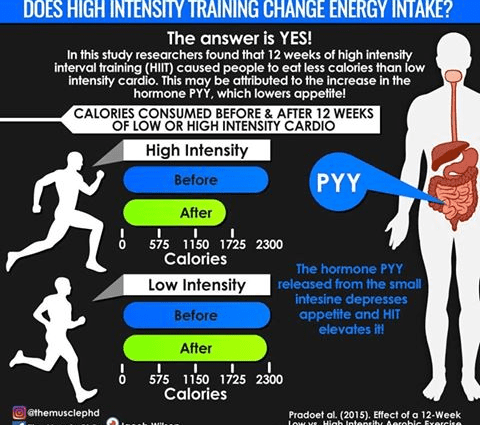Contents
Cardio increases the effectiveness of strength training, improves blood circulation in fatty tissue and promotes fat burning, but there is a debate about which cardio is better – low-intensity or high-intensity. Despite the huge popularity of low-intensity aerobics among professionals and amateurs, recent studies have shown that high-intensity interval cardio (HIIT) burns more calories, but first things first.
Difference between high-intensity and low-intensity cardio
Low-intensity aerobics is continuous, long-term work in which the heart rate is 50-65% of the maximum heart rate. In this workout, the body uses fat as its main source of energy. However, the downside to low-intensity training is that when it ends, fat oxidation also ends, since low-intensity aerobics does not require energy to recover.
High-intensity cardio is continuous short-term work in which the heart rate is between 70-85% of the maximum heart rate. In such a workout, the body uses energy from the muscles, but burns calories afterwards, as after strength training.
What is more effective at burning fat
For the first time, the effectiveness of low-intensity and high-intensity cardio was investigated in 1994. Scientists divided the subjects into two groups, and after 15 weeks they evaluated the results. It turned out that participants in the HIIT group burned nine times more fat than participants in low-intensity cardio. Further research has shown that HIIT trainees have higher fat loss, even if the duration of their workouts is shorter.
Scientists have concluded that high-intensity cardio improves metabolism and fat oxidation. High energy expenditure during a short HIIT workout helps keep fat calories more active during rest. This does not happen with low intensity work.
However, this does not apply to newbies. A recent ACE study, supported by researchers at the University of Wisconsin, found that both training methods work in the same way for beginners. This means that early in your workout, it’s best to get the most out of traditional aerobic exercise, and as you increase in fitness, increase the intensity through intervals.
How to train high intensity
High-intensity interval training involves alternating between short, hard work periods with moderate workouts. The lesson might look like this:
5 minutes warm-up – 50% of the max. Heart rate
3-5 intervals:
- 30 seconds – 70-85% of max. Heart rate
- 60 seconds – 45-65% of max. Heart rate
5 minutes cool down – 50% of the max. Heart rate
In this mode, you can train on any cardio equipment.
If you train at home with your own weight, then for HIIT use alternating complex exercises like burpees, lunges, push-ups, jumps, sprints, with lighter ones – running in place, swinging arms and legs. Jillian Michaels uses this principle in her training, which is why her video courses are so popular and effective.
The downside to HIIT is that it isn’t for everyone. If you have problems with the heart or blood vessels, then before starting classes, be sure to consult with your doctor.
Despite the immense popularity of low-intensity aerobics, high-intensity training is shown to be more effective at burning fat, but this method is suitable for trained and healthy people. Beginners will reap the same benefits from traditional cardio. People with cardiovascular disease should focus on increasing aerobic endurance, improving heart function, and getting into a training regimen gently, which also allows for low-intensity cardio.










